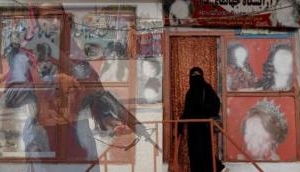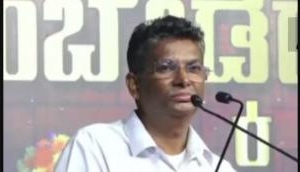
Leontius, the son of Aglaion, was going up from the Piraeus along the outside of the North Wall when he saw some corpses lying at the executioner's feet. He had an appetite to look at them but at the same time he was disgusted and turned away. For a time he struggled with himself and covered his face, but, finally overpowered by the appetite, he pushed his eyes wide open and rushed towards the corpses, saying, "Look for yourselves, you evil wretches, take your fill of the beautiful sight."
-- Plato, Republic
For over a year now, since Russia joined forces with Bashar al-Assad to lay a siege to eastern Aleppo, in September 2015, news of its destruction has been duly shared on our social media timelines.
A siege involves trapping people and denying them supplies until they can no longer fight. If you cut supply lines and bomb people over and over again, the strategic reasoning goes, they are likely to give in.
So, some 2,50,000 people began to be trapped in Aleppo, Syria's largest city, with little food, clean water and even medicine. We saw them being stripped of all fundamental rights. We saw every civilian code of conduct being defied by both sides - the Russian-backed forces of Assad in eastern Aleppo and the "rebel fighters", backed by US, Britain and Saudi Arabia, in the western part of the city.
And we posted and retweeted it all, including the last cries for help from people trapped in east Aleppo that are being posted on social media since yesterday.
We have been confronted with pictures and videos of broken homes, broken citadels, burnt markets, disfigured mosques and air strikes making people drop like flies. And we marked ourselves socially relevant by reacting to them with angry emojis.
Also Read: 'Tyranny has won': 4-year Aleppo war ends as Russia confirms evacuation deal
Then came videos of Aleppo's children. Children covered in dust and blood being rescued, some dead and some alive, their faces dead of any expression, their parents wishing they weren't alive to see this day. It was genocide, we were told. And we clicked on crying emojis and retweeted our own confusion and struggle to grapple with the complex nature of the war and the scale of the atrocities.
As government forces close in on east Aleppo, a "rebel" stronghold for four years now, our timelines have been flooded with real time goodbye messages.

One resident identifying himself as Prof Abdulkafi Alhamdo sits amid ruins and says this in a video: "Assad's militia may be 300 meters away. No place now to go. It's the last place. I hope you can do something. Don't believe anymore in the United Nations... the international community... They want us dead... Exactly yesterday there were many celebrations on the other side of Aleppo. They were celebrating on our bodies... We didn't want anything else but freedom. This war doesn't like freedom it seems."
In another video, an unidentified resident holed up in a dark room, speaks in a hushed, desperate tone: "This could be my final appeal. I am hoping it will find listening ears. Everybody who can, please pressure your government to stop the aggression, to stop the killing, to stop the war."
Other purported residents took to Twitter: "I can tweet now but I might not do it forever. please save my daughter's life and others. this is a call from a father."
"The last message. Thanks for everything. we shared many moments. The last tweets were from an emotional father. Farewell # Aleppo."
As we watched the videos and skimmed through the tweets we wondered if these people had died by the time we read the messages. There are reports of government forces and the "rebels" going around shooting civilians. At least 82 civilians, including women and children, were shot on Monday, according to a spokesperson for the UN High Commissioner for Human Rights.
Also Read: Aleppo tragedy: 10-year-old brother of Syrian boy in haunting photo dies
The world is sharing, retweeting, wringing dry its concerns for humanity on the clothesline of social media. But where is the action? Where are the actionable agendas on creating a safe passage for civilians out of Aleppo? Where are countries, except Canada and Germany, volunteering to open their doors and hearts to Syrian refugees? Where are the urgent solutions to secure the fundamental right to life?
We watch it all
In We Wish To Inform You That Tomorrow We Will Be Killed With Our Families, a chilling account of the Rwandan genocide, Philip Gourevitch recounts how the world watched in silence as nearly one million people - a tenth of the country's population - were killed by their own neighbours and compatriots, mostly with machetes and clubs, in just six weeks.
The title of Gourevitch's book is from a letter written in April 1994 by seven Adventist pastors to their boss, Pastor Elizaphan Ntakirutimana, president of the American-supported Seventh Day Adventist Church in Kibuyu region. The seven pastors were among 2,000 Tutsis who had gathered in a church and hospital complex at Mugonero, believing it to be a sanctuary that would save them from massacre by Hutu mobs. But, according to one survivor of Mugonero, the pastor replied: "Your problem has already found a solution. You must die."
Part of the problem, political critics had said back then, was that the world didn't know what was going on in Rwanda. It happened in secrecy. And news travelled slowly out of the Africa. By the time the media and the international community could grapple with what was going on, it was too late.
Look at Aleppo today. Even with millions of tweets and facebook posts and Youtube videos and Instagram pictures and saturated media coverage and UN meetings and debates in the American and Russian parliaments, the result has amounted to the same inaction. Here, unlike in Rwanda, we know everything. And we watched it all in real time.
"Like Leontius, the young Athenian in Plato, I presume that you are reading this because you desire a closer look, and that you, too, are properly disturbed by your curiosity," Gourevitch had written in his book.
We can't seem to look away. The tragedy of Aleppo has become a reality show that we tune in to daily, only to shed a politically correct humanitarian tear and find out, matter-of-factly, how many more died? The international community does the same.
Leslie Manigat, who came to power in Haiti in the wake of the spectacularly violent election of 1987, argues that Leontius should shed his guilt and look long and hard. For to understand the real workings of a society, one must find a way to see beneath the surface, and the most effective way to do that is through the portal of political violence.
Like Leontius, we must look long and hard at Aleppo and let it haunt us for long before we can commit ourselves - yet again - by saying "Never Again", in more ways than in just a tweet.
Also Read: Airstrike kills 'clown of Aleppo' who cheered up countless children in war-torn Syria
First published: 14 December 2016, 8:58 IST







![BJP's Kapil Mishra recreates Shankar Mahadevan’s ‘Breathless’ song to highlight Delhi pollution [WATCH] BJP's Kapil Mishra recreates Shankar Mahadevan’s ‘Breathless’ song to highlight Delhi pollution [WATCH]](https://images.catchnews.com/upload/2022/11/03/kapil-mishra_240884_300x172.png)

![Anupam Kher shares pictures of his toned body on 67th birthday [MUST SEE] Anupam Kher shares pictures of his toned body on 67th birthday [MUST SEE]](https://images.catchnews.com/upload/2022/03/07/Anupam_kher_231145_300x172.jpg)






